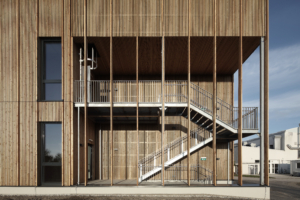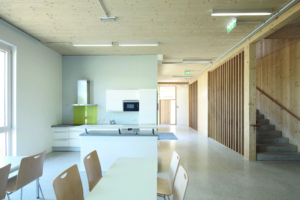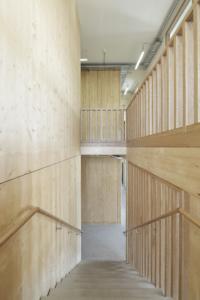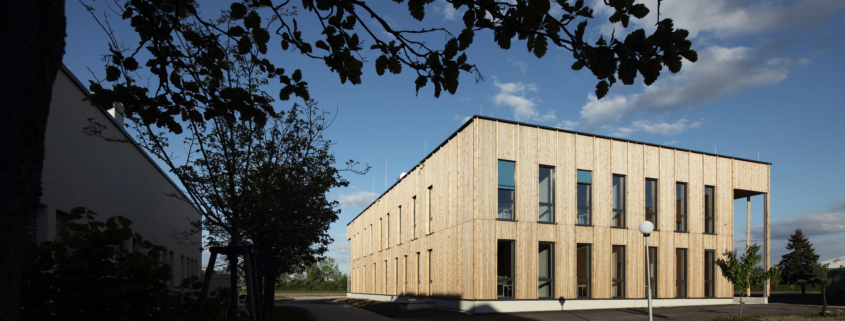The first Austrian laboratories and offices from wood
As of 2017, the University of Natural Resources and Life Sciences BOKU in Vienna has had a new building made completely from wood. It is an exceptional building, which meets economical, ecological as well as social aspects of sustainability.
 The author of the architectural concept is DELTA and the SWAP Studio. The two-story timber-frame building of about 1,300 sq m was built in only a year and became a very well-appointed facility for a new research centre and the Institute for Agrobiotechnology IFA in Tulln, Austria.
The author of the architectural concept is DELTA and the SWAP Studio. The two-story timber-frame building of about 1,300 sq m was built in only a year and became a very well-appointed facility for a new research centre and the Institute for Agrobiotechnology IFA in Tulln, Austria.
A well-thought through concept of a building
 The analytic centre is situated on the ground floor, next to the foyer and a salon with a ward kitchen. The premises for the Institute for Environmental Biotechnology are on the top floor. the heart of the two-story timber-frame building and thus a central gathering place is a conference and common room with a kitchenette on the ground floor. Technological background facilities are in the basement.
The analytic centre is situated on the ground floor, next to the foyer and a salon with a ward kitchen. The premises for the Institute for Environmental Biotechnology are on the top floor. the heart of the two-story timber-frame building and thus a central gathering place is a conference and common room with a kitchenette on the ground floor. Technological background facilities are in the basement.
Ecological as well as energetic wood quality
 Three years of this building’s operation show that the modern timber-frame structure meets low-energy standards. Wood as a building material can be seen on a façade and also creates unchangeable aesthetics inside the building. There were approximately 500 m3 of timber from local woods used for the construction. All offices face south or west and benefit from an abundance of natural daylight. The laboratories were intentionally planned for the northern side in order to allow for work without being blinded. Thanks to its clear structure, the building fits in well with the character of the existing campus of the other buildings. Floor heating creates a comfortable environment, especially in the winter; heating is supplied via remote heat line. “With the selection of the timber-frame structure, we decided for an extra sustainable and highly functional material. We are astounded by wood’s qualities and advantages as a building material with regards to the speed of the construction process, cost effectiveness of the building and ecological as well as energetic quality of the new university building,” says Erik Štefanovič from DELTA Czech Republic with regards to the building.
Three years of this building’s operation show that the modern timber-frame structure meets low-energy standards. Wood as a building material can be seen on a façade and also creates unchangeable aesthetics inside the building. There were approximately 500 m3 of timber from local woods used for the construction. All offices face south or west and benefit from an abundance of natural daylight. The laboratories were intentionally planned for the northern side in order to allow for work without being blinded. Thanks to its clear structure, the building fits in well with the character of the existing campus of the other buildings. Floor heating creates a comfortable environment, especially in the winter; heating is supplied via remote heat line. “With the selection of the timber-frame structure, we decided for an extra sustainable and highly functional material. We are astounded by wood’s qualities and advantages as a building material with regards to the speed of the construction process, cost effectiveness of the building and ecological as well as energetic quality of the new university building,” says Erik Štefanovič from DELTA Czech Republic with regards to the building.
Sustainable reflexions throughout its lifespan
 The reasoning for the use of a timber-frame building came from the results of an architectural tender. Fast implementation, a high rate of flexibility when used and ecological factors convinced the investors of BIG and BOKU about the correctness of the ARGE DELTA SWAP concept. Economic advantages mainly stem from a time factor – what was decision making were the effective production processes, short assembly time at the building site and immediate load-bearing capacity of the structure. As for the ecological point of view, wood is an ideal building material as it is a renewable resource, which is 100% usable and recyclable.
The reasoning for the use of a timber-frame building came from the results of an architectural tender. Fast implementation, a high rate of flexibility when used and ecological factors convinced the investors of BIG and BOKU about the correctness of the ARGE DELTA SWAP concept. Economic advantages mainly stem from a time factor – what was decision making were the effective production processes, short assembly time at the building site and immediate load-bearing capacity of the structure. As for the ecological point of view, wood is an ideal building material as it is a renewable resource, which is 100% usable and recyclable.
The DELTA SWAP concept also has social aspects: “The homely character of wood emphasises students’ working environment. The clear working processes of the research company are also reflected in strictly rhythmically situated window openings,” explain architects Georg Unterhohenwarter and Markus Hofwimmer from ARGE DELTA SWAP. Apart from the fact that the new building is made from wood, it is also distinguished for its compact silhouette outline. The interior part of the building is divided into zones; partition walls inside the zones are not designed as load-bearing, so the rooms can be modified flexibly. The concept of the building is really well-thought out to the slightest detail in accordance with DELTA green line principle that the architects abided by and thanks to which they managed to convince the committee and win first place in the category of timber-framed public buildings.
red / Photo: Christian Brandstätter



